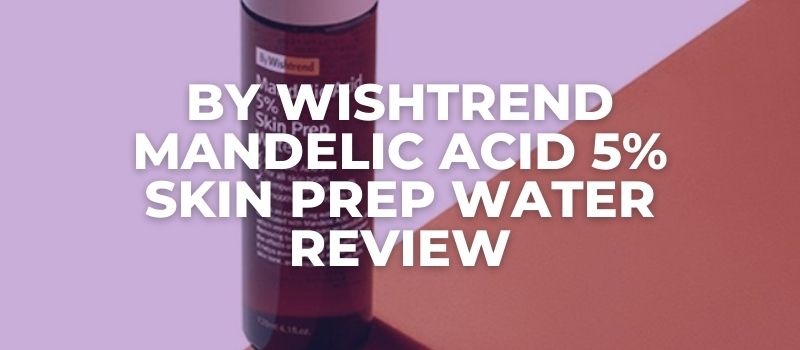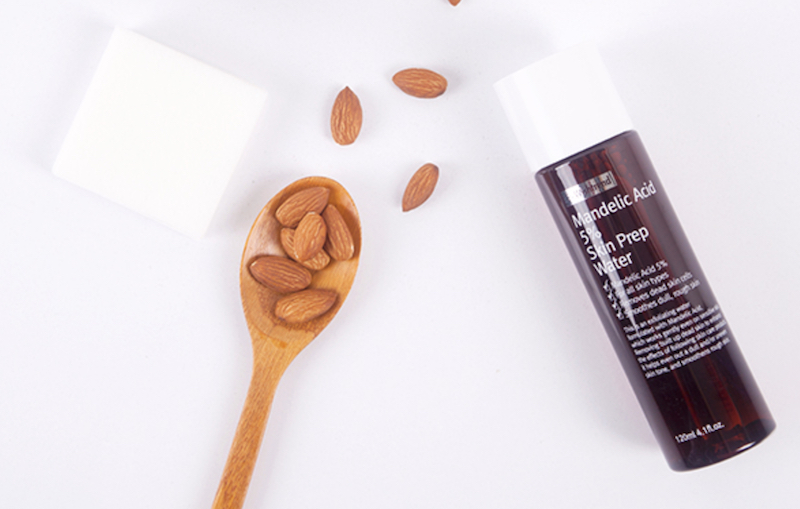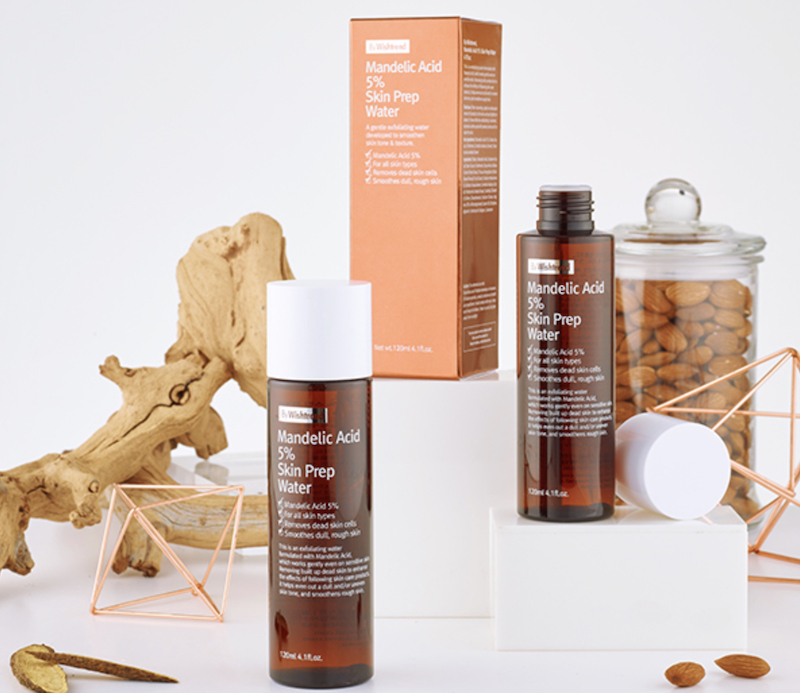Dark spots, wrinkles, dullness, and acne scars are skincare issues that many people are looking to overcome, therefore, the good news is that many over-the-counter products nowadays include ingredients that address these specific concerns.
Mandelic acid is one that falls in the category of these beneficial ingredients, therefore this is what I want to talk to you about in today’s article.
And since my newfound love for Korean skincare is all the jazz these days, let’s address one product I have been enjoying lately.
Keep reading my By Wishtrend Mandelic Acid 5% Skin Prep Water Review to learn how to use this particular product in the most beneficial way for your skin.
TLDR: I enjoyed using this Mandelic Acid from By Wishtrend and I was definitely glad the little pigmented spots from past acne didn’t stick around as long as they usually do. The product is definitely worth giving a shot.

What Is Mandelic Acid?
Mandelic acid is an increasingly popular alpha hydroxy acid derived from the hydrolysis of an extract of bitter almonds.
Mandelic acid has a slightly different structure and performance than alternative aha ingredients such as glycolic acid.
While they both work to address similar skin concerns, these two are not the same, therefore, you should always educate yourself on both in order to know which one will be more beneficial for your skin type and the skin concern you want to target.
Glycolic acid is another AHA that is widely used in many skincare products for the sole reason that it works excellently. It is derived from sugar cane and is effective at exfoliating the skin just as much.
Glycolic acid has the smallest molecular weight among all other AHAs, and thus penetrates the skin more easily. For this reason, glycolic acid may be more irritating to the skin than mandelic acid.
Mandelic acid, on the other hand, has a larger molecular structure than glycolic acid, which means it doesn’t penetrate the skin as deeply as glycolic acid, so its action is significantly gentler.
It has been extensively studied for its uses in treating common skin problems such as photo-aging (skin aging caused by the sun), irregular pigmentation (such as melasma and lentigo), and both inflammatory and non-inflammatory acne.
One of these studies shows that different percentages of mandelic acid can have the upper hand in successfully treating inflammatory acne over salicylic acid.
Additionally, using mandelic acid to treat acne can have significantly fewer side effects such as inflammatory reactions as well as post-inflammatory hyperpigmentation.
Additionally, the notable difference between glycolic acid and mandelic acid is the lack of post-inflammatory erythema that often accompanies skin treatments with mandelic acid.
This is one of the many positive differences between the two forms of chemical exfoliators, making mandelic acid a safer medium to work with both professionals and products recommended for home use.
Can You Use Mandelic Acid Every Day?

Results of many studies clearly show that home-use products containing 5% or 10% mandelic acid are both safe and effective for treating various skin concerns.
However, mandelic acid is, after all, an exfoliating solution. And in order to understand how exfoliation works on the skin, you have to first understand how healthy skin behaves.
Exfoliation is something that happens regularly in a good skincare regimen and it is the one factor responsible for removing the buildup of dead, keratinized skin cells to make way for the new cells underneath.
This will, in turn, give your complexion a healthy, radiant, and brighter appearance.
However, healthy skin, or more specifically a healthy epidermis, is not about how young the skin cells are, but how well the cells are able to communicate with other cells across the layers of the epidermis, how well they are able to interface with something called the “skin microbiome’, and how well they are able to relate with their immediate environment.
Within the skin is a collaborative environment where interactions are key to how well synergies and symbiosis can take place and consequently how a healthy skin environment can emerge and be maintained.
This works like an ecosystem of cells, micro-organisms, and the environment.
The dead skin cells or “corneocytes” are indispensable in this healthy ecosystem, even though they may technically be considered “dead”.
The most optimal corneocytes are the ones that have fully matured and are flattened and larger in shape and size.
No, they do not look plump, bright, or radiant, but their maturity, structure, fortified cell walls, and higher surface area allows them to hold the most amounts of what are called the Natural Moisturizing Factors or NMFs.
NMFs are what allows the skin cells to hold on to water and maintain optimal hydration levels within the outermost layer of the epidermis, the stratum corneum.
Young and fresh cells are not able to hold on to much water because they are simply not strong enough to withstand the osmotic pressure of water building up within the cells.
Over-exfoliation removes the matured corneocytes, leaving behind immature cells that may look bright, plump, and radiant, but this also leaves your skin unable to keep itself hydrated.
Therefore, while regular exfoliation should still take place in a good skincare regimen, this is definitely a process that needs to be reserved for no more than 2-3 times a week.
Mandelic Acid 5% Skin Prep Water by Wishtrend.

So after getting the important stuff out of the way, let’s continue with reviewing the Mandelic Acid 5 Skin Prep Water.
First off, I live in Europe, therefore receiving Korean products usually takes much longer than it probably does for other countries, however, after a long wait, I finally received this rather exciting product launch By Wishtrend.
And after using it for some time, I have some opinions to share.
Consistency.
The product has a liquid and colorless consistency and comes in a sleek and elegant-looking bottle.
Liquids are ideal when it comes to exfoliation as they have the ability to penetrate into the skin fast and stay there in order to do their magic.
Smell.
Now here’s the thing. I have tried so many products since I started taking interest in skincare and not all of them smell nice.
In fact, I prefer products that have zero fragrance or essential oils used to make the product smell nice and therefore, sell well.
The truth is that raw ingredients don’t smell good, and I have used products that have done absolute wonders for my skin but smelled like wet socks.
So, I cannot say I am bothered with the slightly medicinal scent the Mandelic Acid Skin Prep Water has, but it is definitely there if you take a closer whiff.
And that makes sense since this product contains various other extracts as well as the main ingredient which is a derivative of bitter almonds.
This product doesn’t contain any artificial fragrance or essential oils to make it smell nice, so I would take a mild medicinal smell over artificial scents any day, and it is not a deal-breaker for me.
Just sayin’
Ingredients.
And my favorite part to pick apart is definitely this one, so let’s start.
Besides the first two ingredients being water and mandelic acid, here is a list of the rest most notable ingredients well as what exactly do they do for your skin:
Butylene Glycol.
Butylene Glycol is a multi-talking, colorless liquid that acts as a solvent for the other ingredients and helps them to absorb faster and deeper into the skin.
Additionally, due to its syrupy consistency, Butylene Glycol makes the product spread nicely over the skin and it also serves as a humectant to attract water from the environment and into the skin.
Beta-Glucan.
Beta-Glucan is a great ingredient most compatible with sensitive skins. It has a large molecule structure composed of other smaller sugar molecules called polysaccharides.
It can be found in the cell walls of yeast, some mushrooms, seaweeds, and cereals.
Additionally, besides having soothing and moisturizing properties, Beta-Glucan also has wound-healing properties and it serves as a mild antioxidant that shows promising anti-aging benefits.
Panthenol.
Panthenol or also called pro-vitamin B5 is a precursor to vitamin B5 or commonly known as niacinamide.
It is used in cosmetic products as a humectant to help the skin attract moisture from the environment and successfully hold onto it.
Additionally, Panthenol has anti-inflammatory and skin protecting abilities, in the sense that it helps the skin produce lipids that are important for a strong and healthy skin barrier.
Additionally, some research shows that Panthenol might be useful for wound healing as it promotes fibroblast proliferation which are the cells in our skin that produce collagen.
Glycyrrhiza Glabra Root Extract.
Glycyrrhiza Glabra Root Extract or commonly known as Licorice Extract (because ain’t nobody got time for pronouncing that) is a known skincare superstar thanks for its skin-lightening and anti-inflammatory properties.
The most active part of licorice extract is called glabridin which helps inhibit UVB caused pigmentation and is considered to be one of the safest skin lightening agents with the fewest side effects.
Additionally, glabridin has soothing properties, however, the main active anti-inflammatory component is glycyrrhizin that is used to treat several skin diseases that are associated with inflammatory responses such as atopic dermatitis, rosacea, and even eczema.
Sodium Hyaluronate.
Sodium Hyaluronate is the cousin of the more popular hyaluronic acid. In skincare, they are pretty much the same and the two names are used interchangeably.
What seems to be the difference between the two is that the sodium form is more stable, easier to formulate, and cheaper than hyaluronic acid, therefore, it often pops up more often on the ingredient list, especially when it comes to more affordable products.
Sodium hyaluronate is not smaller and doesn’t penetrate the skin any better than hyaluronic acid does, contrary to the popular opinion, as the two forms are almost the same.
They are both responsible for delivering a shot of hydration into the skin and maintain moisture.
Centella Asiatica Extract.
Centella Asiatica is an ingredient that has been used in folk medicine for hundreds of years due to its ability to heal small wounds, burns, scratches, or soothe inflammatory conditions such as eczema.
Centella Asiatica contains centellosides, which are able to stimulate hyaluronic acid synthesis in our skin and therefore moisturize the skin.
Additionally, due to the content of asiaticoside, this superstar ingredient can increase antioxidant levels in our skin.
Houttuynia Cordata Extract.
Houttuynia Cordata is a plant that contains active components known as flavonoids and these exhibit anti-inflammatory, antioxidant, and antibacterial properties in skincare products.
Additionally, one active component known as Quercitrin has also been shown to mildly decrease UV damage on the skin.
Sorbitol.
Sorbitol is a sweet sugar substitute that helps to thicken products and give them the ability to glide easier when applied on the skin.
Additionally, Sorbitol helps your skin hold onto water when used in cosmetic products.
Arginine.
Arginine is a semi-essential amino acid that is one of the primary building blocks for hair keratin and skin collagen.
It is a natural moisturizing factor, a skin hydrator, and helps to speed up wound healing.
When used in exfoliating products, Arginine creates a complex with AHAs that causes a “time-release AHA effect” which reduces the irritation often associated with using AHAs.

My name is Simone and I am a certified skin specialist. I created this website to teach my readers how to take great care of their skin and I also like to occasionally share my honest opinions on skincare products I’ve tried. You can learn more about me here.
